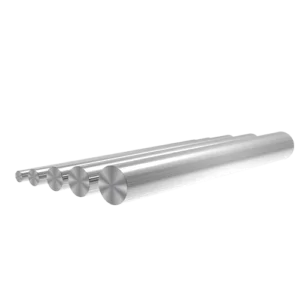Introduction

In the vast landscape of industrial manufacturing, few innovations have wielded as much influence as steel rods. From their humble beginnings to their indispensable role in modern production processes, steel rods have revolutionized various industries. This article delves into the journey of steel rods, exploring their historical significance, manufacturing processes, applications, and the pivotal role they play in shaping the industrial world.
A Brief History of Steel Rods
Steel rods have a rich history dating back centuries. Initially crafted through primitive smelting techniques, early civilizations recognized the durability and versatility of steel rods for various applications, ranging from weaponry to rudimentary tools. Over time, advancements in metallurgy and manufacturing processes refined the quality and production of steel rods, paving the way for their widespread adoption in industrial settings.
The Manufacturing Process of Steel Rods
The production of steel rods involves a complex series of steps, each crucial in determining the quality and properties of the final product. From the extraction of raw materials to the precision machining of finished rods, modern manufacturing facilities employ state-of-the-art technologies to ensure efficiency and consistency. This section provides an in-depth exploration of the manufacturing process, highlighting key techniques such as hot rolling, cold drawing, and heat treatment.
Steel Rods: Versatile Applications Across Industries
Steel rods serve as the backbone of numerous industries, thanks to their exceptional strength, durability, and machinability. Whether in construction, automotive, aerospace, or infrastructure development, steel rods find diverse applications, ranging from structural supports to component manufacturing. This section examines the various sectors that rely on steel rods and explores the specific roles they play in enhancing product performance and reliability.
The Advantages of Steel Rods in Industrial Manufacturing
Steel rods stand out in industrial manufacturing due to their exceptional properties, offering a multitude of advantages over alternative materials. Let’s delve deeper into these benefits:
High Tensile Strength and Resilience
Steel rods are renowned for their remarkable tensile strength, allowing them to withstand immense loads without deformation or failure. This inherent strength makes steel rods indispensable in applications where structural integrity is paramount, such as in construction, infrastructure development, and heavy machinery. Whether supporting towering skyscrapers or bearing the weight of massive equipment, steel rods provide unparalleled reliability, ensuring safety and durability in demanding environments.
Moreover, the resilience of steel rods enables them to endure harsh environmental conditions, including extreme temperatures, corrosive substances, and abrasive forces. Unlike other materials that may degrade or weaken over time, steel rods maintain their structural integrity, prolonging their lifespan and minimizing maintenance requirements. This resilience makes steel rods ideal for outdoor applications, such as bridges, pipelines, and offshore platforms, where exposure to the elements is unavoidable.
Superior Machinability
One of the key advantages of steel rods is their exceptional machinability, which allows for precise shaping and customization according to specific project requirements. Whether cutting, drilling, or welding, steel rods can be easily manipulated to achieve intricate designs and configurations, making them versatile options for a wide range of manufacturing processes. This flexibility enables engineers and designers to realize complex structures and components with ease, fostering innovation and creativity in product development.
Furthermore, the machinability of steel rods enhances production efficiency, reducing manufacturing lead times and costs. With faster processing speeds and minimal material wastage, manufacturers can optimize their operations and meet tight deadlines without compromising quality. This efficiency translates to significant cost savings over time, making steel rods a cost-effective choice for industrial applications.
Emphasis on Cost-Effectiveness, Longevity, and Sustainability
In addition to their inherent strength and machinability, steel rods offer compelling cost-effectiveness, longevity, and sustainability compared to alternative materials. While the initial investment in steel rods may be higher than that of some alternatives, the long-term benefits far outweigh the upfront costs. The durability and resilience of steel rods minimize the need for frequent replacements and repairs, reducing lifecycle expenses and downtime in industrial operations.
Moreover, the recyclability of steel rods contributes to their sustainability credentials, making them environmentally friendly options for manufacturers conscious of their ecological footprint. By incorporating recycled steel into production processes, companies can minimize waste generation and energy consumption, supporting a circular economy and reducing dependence on finite resources.
Comparison of Steel Rods with Other Materials

| Property | Steel Rods | Aluminum Rods | Titanium Rods |
|---|---|---|---|
| Tensile Strength | High | Moderate | Very High |
| Density | Medium | Low | Low |
| Machinability | Excellent | Good | Moderate |
| Corrosion Resistance | High | Moderate | High |
Conclusion
In conclusion, the evolution of steel rods represents a remarkable testament to human ingenuity and innovation in the field of industrial manufacturing. From ancient civilizations to modern-day industries, steel rods have remained indispensable components, driving progress and development across diverse sectors. As technology continues to advance, the legacy of steel rods endures, promising to shape the future of manufacturing and engineering for generations to come.
FAQ
Q:What are the primary types of steel rods available in the market?
A:Steel rods come in various types, including carbon steel rods, stainless steel rods, and alloy steel rods, each tailored to specific applications based on their composition and properties.
Q:How do steel rods differ from other metal alloys?
A:Unlike traditional metals like aluminum or copper, steel rods offer superior strength, durability, and versatility, making them preferred choices in demanding industrial environments.
Q:What factors should one consider when selecting steel rods for a project?
A:When choosing steel rods, factors such as tensile strength, corrosion resistance, and machinability should be taken into account to ensure optimal performance and longevity.
Q:Can steel rods be recycled?
A:Yes, steel rods are highly recyclable, making them environmentally sustainable options for industrial applications. Recycling steel helps conserve resources and reduces carbon emissions associated with manufacturing.
Q:How do advancements in steel rod technology impact industrial manufacturing processes?
A:Technological advancements in steel rod manufacturing, such as automation, computer-aided design, and precision machining, enhance efficiency, quality, and customization capabilities, driving innovation and competitiveness in industrial manufacturing.
